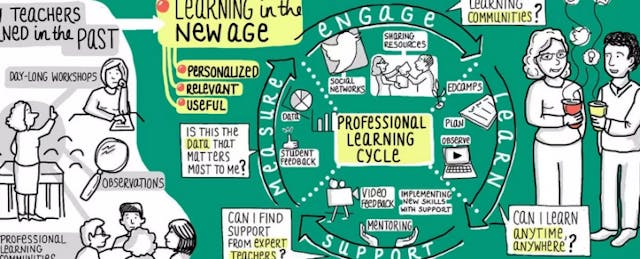Personalized learning is on the rise for learners in our schools. Redesigned schools include personal learning plans, playlists of content tailored to fit each learner, adaptive curriculum, and access to learning anytime and anywhere.
That's great for students. But what about our teachers? Where's the personalized learning, the carefully constructed playlists, the pitch-perfect material that fits their grade level and subject needs and interests?
It’s emerging, but it’s few and far between or at least that’s what we found from over a year of researching professional development.
In 2013, with the support of the Gates Foundation, EdSurge began to explore how technology was supporting professional development. We began by assessing the needs for professional learning, starting with what educators liked and what they didn’t about the current opportunities they were given. We surveyed over 400 educators and conducted in depth interviews with 50 educators. Then we mapped all the different use cases for products on the market to see where they overlapped.
Here are a few insights that emerged:
- Most products can be accessed anytime and anywhere. More than 89% of the 28 tools we profiled can be accessed remotely and without a commitment to a specific time or place.
- Video is a popular tool. However you slice it, video plays a big role in emerging PD tools. Over 64% of the tools we examined involve some video component in the learning process, whether video modules, video of other teachers modeling best practice, or self-made video for feedback.
- Adaptive is rare but happening. While students increasingly have access to curriculum and learning materials that adapt to their skill levels, this feature is hard to find among professional development tools. A few virtual experiences are building a case for adaptive learning for teachers.
- Informal learning needs to play a role. Teachers say again and again that they get the most value out of informal learning opportunities such as EdCamps and Twitter chats. That suggests these activities need to be leveraged and included in their professional development.
As a result of our one-year study, we developed a framework, the “Professional Development Learning Cycle,” which captures how tools support teacher’s preferred mode of learning. We mapped 28 tools to the framework and published in depth reports on how these tools work. The work is summarized in our new free 66-page report titled, “How Teachers Are Learning: Professional Development Remix.”
Through this work, we developed a keen eye for what’s working, what isn’t, and what tools might get us closer to personalized PD. In the report we share some of our insights on various topics: what’s available in the current market, what’s missing, and what’s emerging as valuable sets of features and products. But at the end of the day, it comes down to teachers and how much control they have over their learning.
While the tools are still developing, some teachers and schools are beginning to combine different tools to brew their own personalized professional development (more stories from how teachers and administrators are making that happen in our PD Guide). Some might choose a combination of Twitter, video libraries of best practice, and social networking for badging. For others, a path to personalized PD might involve in-person coaching and online courses, combined with video feedback tools.
The Free EdSurge PD Report. Read about PD Tool Comparisons, Trends & Themes, and Methodology & Framework Details.
Click here to Download Report


